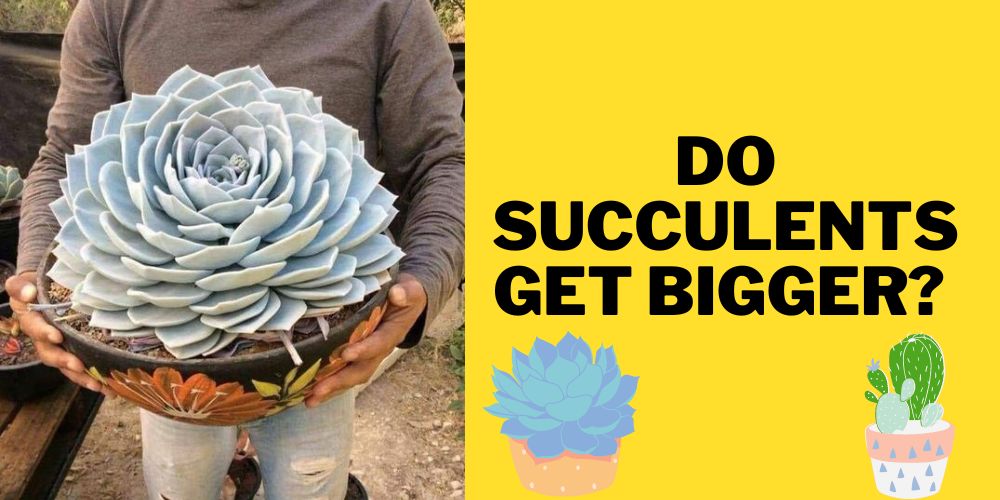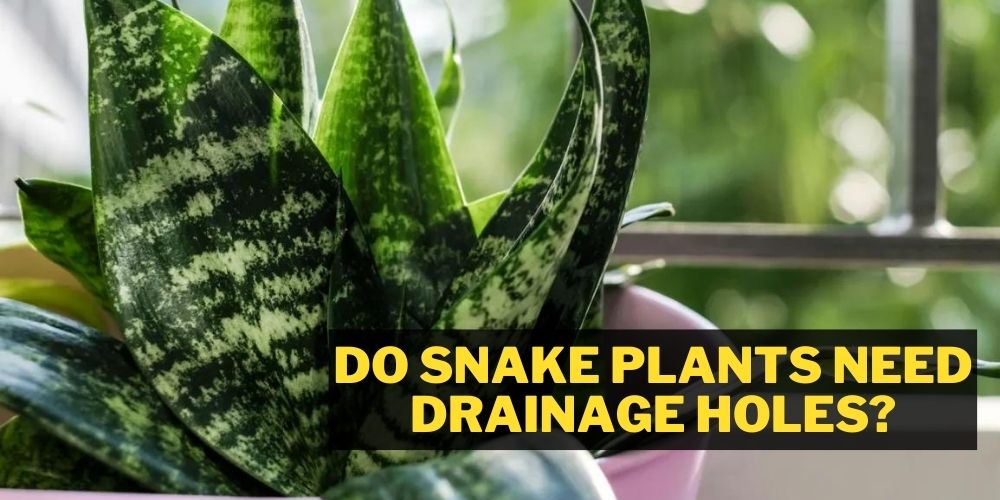Succulents have become extremely popular in gardening over the last few years. It’s hard to fault them. They are quite inexpensive, they are low maintenance, and they are a joy to watch grow. One of the issues that succulent growers have is when they start to grow taller but not wider.
But why succulent growing tall instead of wide? Well, I’ll explain the reasons here.
The condition is known as etiolation and is usually caused by a lack of light. Sadly, once the problem goes too far, it is almost impossible to stop. They often look stretched, thin, pale, leggy, and weak.
Some of our plants have also gone through this dilemma.
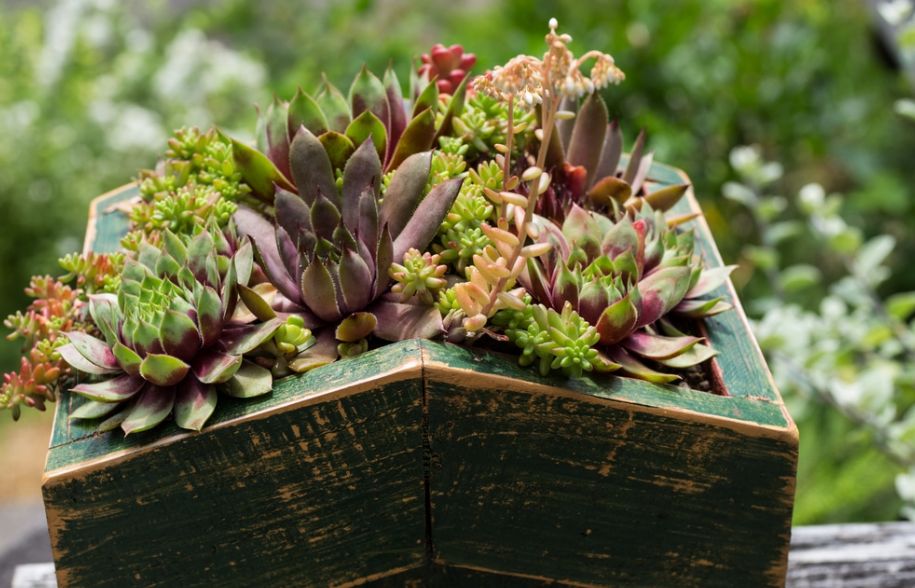
Through trial and error, we’ve learned what to and what not to do to ensure this doesn’t occur again. Hopefully, our detailed research on this topic will help you correct the issue and assist with your plant’s health and appearance.
Table of Contents
Is it normal for succulents to grow a tall stem?
It is normal for succulents to grow a tall stem as long as they present their typical characteristics.
These include their leaves being of normal shape, the whole plant hasn’t discolored, and there aren’t any longer than usual gaps along the stem between nodes.
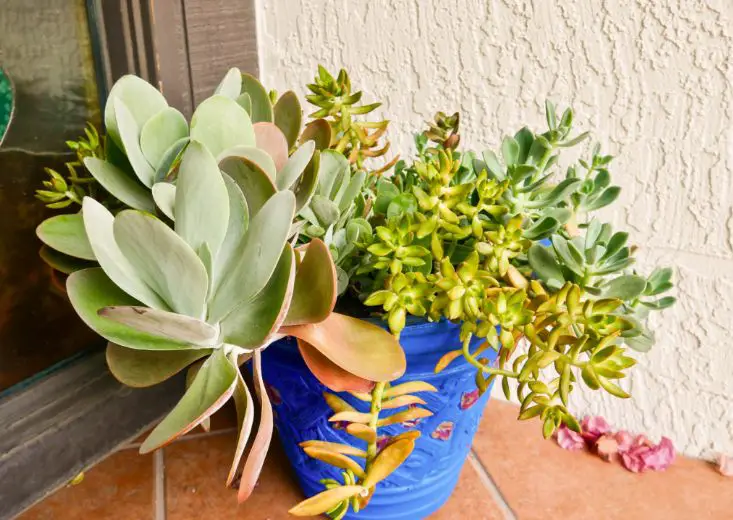
Succulents don’t grow as fast as normal plants, so they can take longer to grow to proportional sizes upwards and outwards. This is often more so with indoor growing succulents than those grown outside amongst the elements.
How to Recognize a Stretched Out Succulent?
The first sign of your succulent plant becoming stretched out is how it looks. Suppose it’s growing taller but not wider; there could be a reason for concern. As we just mentioned above, it is also ok for a succulent to grow a taller stem because it doesn’t present itself with specific visual characteristics.
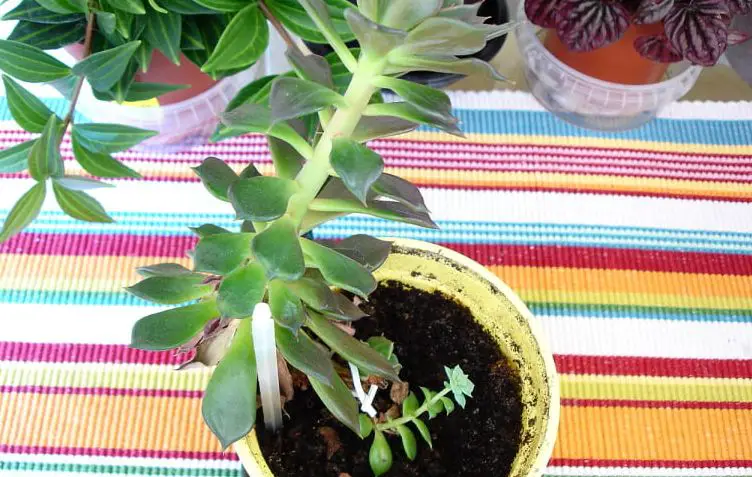
A healthy plant generally grows proportionally, so seeing one with a weak, leggy look may require immediate attention. If your succulent is trying to bend itself toward a light source, it’s a sign that it’s desperate for light. As it bends, it also stretches out.
A succulent’s leaves can also start to point downwards to gain access to a source of light. These are a few minor things to keep an eye on to help recognize when your succulent can start to become stretched out. Paying attention to these signs will ensure your plant stays healthy and happy.
Why Succulent Growing Tall Instead of Wide? (The Actual Reason)
The root problem (mind the pun) with a succulent growing taller instead of wider is insufficient light. Most species of succulents need sunlight to thrive and survive, and 4-6 hours of sunlight per day is optimal for a succulent plant to remain healthy.
Any less, you will start to see visual signs that include unproportionally increased height but not width, legginess, discoloration and spacey/spread-out leaves. The sunlight helps the succulent with its photosynthesis process, much like any plant.
This enables them to produce the food they require to survive their lives as a plant. They stretch and bend towards their light source to bathe in its rays. Depending on the succulent species, some require direct or indirect sunlight. Either type will give the plant optimal conditions to benefit from this process.
How much light do the succulents need?
A succulent needs 4-6 hours of either direct or indirect sunlight daily. Direct sunlight is just that, sunlight that shines directly onto the plant without any hindrance.
Indirect sunlight is a form of light that aims to shine directly onto the plant but isis obscured by clouds preventing the sun, moving shadows/shade, other plants/trees/shrubs, etc. Anything that can break up the full exposure of the sun’s rays.
What is etiolation?
Etiolation is how a plant develops with inadequate or a complete absence of light during this process.
Some visual signs of this condition are long and weak stems (leggy), uncharacteristically smaller leaves created by longer internodes and discoloration (usually pale yellow).
If a seed is forced to propagate under these conditions, it can take much longer to sprout or misfire. This can be referred to as skotomorphogenesis or seed etiolation.
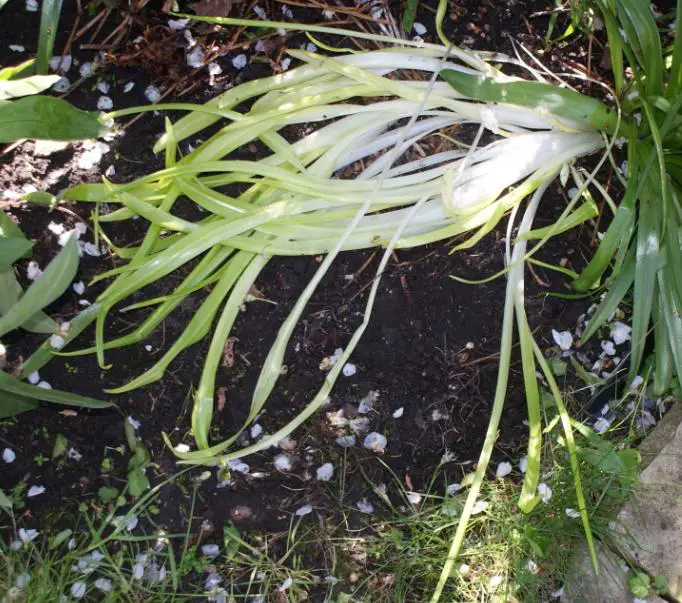
The easiest way to prevent etiolation is to give the plant some light if possible. They will usually fight their way to find a source, but sometimes they can only do so much before giving up.
Is etiolation bad for succulents?
Etiolation isn’t bad for plants, it can stunt their outward growth, but they will always try to fight tooth and nail for the light they require. It does not harm the plants short term in any way from a growing perspective. It can, however, affect their ability to be aesthetically pleasing.
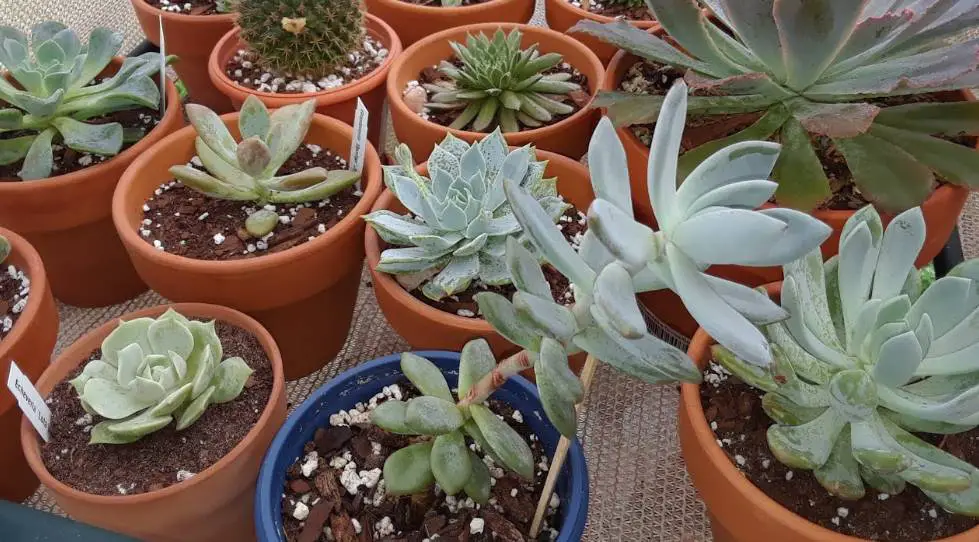
They wouldn’t look as attractive as a perfectly healthy plant, and they would appear weak and pale in their color tones. If a succulent was to be denied sunlight for an extended period, the plant would die as a result.
Any plant requires sunlight to survive, and it’s just one of the key elements to producing photosynthesis! This condition is more common for indoor plants as there is less chance of natural sunlight in unnatural manmade surroundings.
Can you reverse etiolation?
Etiolation of an already stretched succulent cannot be reversed. What you could do, though, is prune any leggy parts of your plant above a node to encourage regrowth. Before proceeding, though, another thing to consider is placing your plant somewhere with more sunlight than it is already receiving to allow it to grow into a bit of a better shape.
It may start to grow outward from the pre-existing nodes. If this is the case, the plant will become more full, which deems pruning any leggy stems not as high risk as it would have before encouraging growth via increased light.
How to fix elongated succulents?
There are a few options you can try to correct any issues your succulent may have with elongation. The key is to offer more light and encourage growth. Let’s look at some actionable steps you can take to help revive your leggy succulents.
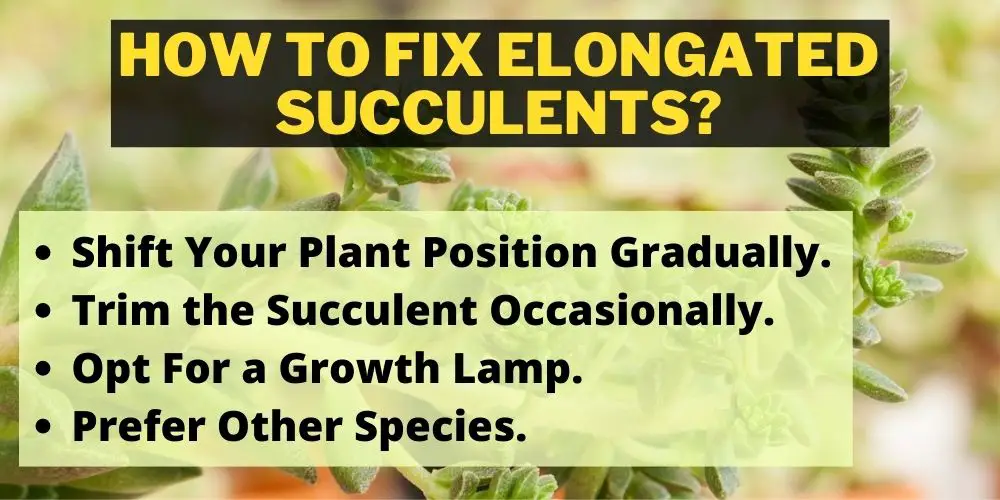
Shift Your Plant Position Gradually
We use the word gradually because you don’t want to over-stimulate your succulents. They would have adapted to their current conditions, so any sudden changes to their growing environment can and will shock their system, and this can cause much larger issues.
The best way to achieve a more natural move is to move them closer and closer to the light source each day. Alternatively, move your succulents into full light gradually, which eventually leads to their optimal 4-6 hours per day.
Eg:
- Day 1 – 3 (30 mins)
- Day 4-7 (45 mins)
- Day 8-14 (1 hour)
- Day 15-21 (2 hours) Etc.
Trim the Succulent Occasionally
Another tactic that is worth trying is trimming back your plant. If a succulent is pruned correctly, it will have every chance possible to grow more outwards. The best plan of attack to achieve this outcome is to first find a leaf node on your plant’s stem.
It will resemble something like a nob(s) that looks like they could produce another stem from that spot. Once you have located a node, trim the plant just above the node. If done so correctly, you will have removed a leggy stem and encouraged the succulent to regrow from the node.
It’s not uncommon for nodes to multiply as you trim them. The plant will stop focusing all its energy on feeding up to the tip of the leggy stems and use the energy to try to burst out of the nodes instead. If you accidentally trim below the node, it will take a little longer to reproduce.
Opt For a Growth Lamp
A growth lamp is another great option worth exploring. Especially if your succulent is growing somewhere with little or no sunlight access. There is a huge range on the market these days, and the technology is amazing in how they can function.
The aim is to simulate the sun and its specific rays to enable the plant to grow in the way it was designed. You can get some simple ones like this on amazon, including a handy on/off timer.
Prefer Other Species
If you don’t feel that any of the above solutions are for you, you can choose a species that doesn’t require as much sunlight.
There are succulents out there that can survive much longer without sunlight, and a choice like this will help alleviate the issue of the plant being too tall and not wide enough.
Species such as the Peace Lily, Silver Inch Plant, Moth Orchid and the Swiss Cheese Plant are just a few great plants that fit the bill regarding minimal sunlight requirements.
Frequently Asked Questions (FAQs)
What do I do if my succulent is too tall?
A few simple fixes encourage wider growth with your succulent plant. You can move your plant around gradually. Relocating your plant towards southern exposure is the first thing you should do if it isn’t already facing that direction, as the south will offer more sunlight.
Another option is to get a grow light to assist with the light deficiency. You can also trim your succulents occasionally to encourage new growth outwards.
How do you shorten tall succulents?
The easiest way to shorten a succulent is to trim it back. Simply locate a leaf node and cut away the stem just above the node. If done correctly, the node should burst out new growth in a few weeks. Try to make sure that the cut is clean to allow every opportunity to regrow.
Can I cut the top off my succulent?
You can cut the top or ‘head’ off your succulent. Try to locate each stem and where their tops/heads are so you don’t trim away too many.
Aim to remove 1-2 at a time and see how the plant responds. Maintaining your plant by removing any dead or discolored parts, including leaves and stems, is always good practice.
When should succulents be repotted?
As a general rule, succulents should be repotted every 12-18 months. When repotting, it is advised to keep the plant in the shade for at least 2 weeks to allow it to adjust to its new home.
Some species of succulents are comfortable in the same pot for longer than this time, but keeping a tight repotting schedule will make your job less challenging, especially if you have many plants to tend to.
Conclusion: :
As you can see, the main reason succulents grow tall and leggy instead of full and wide is their lack of access to sunlight. Adequate light is one of the most important elements to almost all plant species’ survival.
Some succulent plants can survive on little water and sunlight, but those that can’t show clearly visible signs aren’t coping too well with the deficiency.
The best thing to do is move them to a spot where they can soak in the sun’s rays. If this is not possible, a grow light can do the job just as efficiently, if not better these days. We hope that you have found this article helpful, and we look forward to producing more content like this in the future.
Happy growing!

